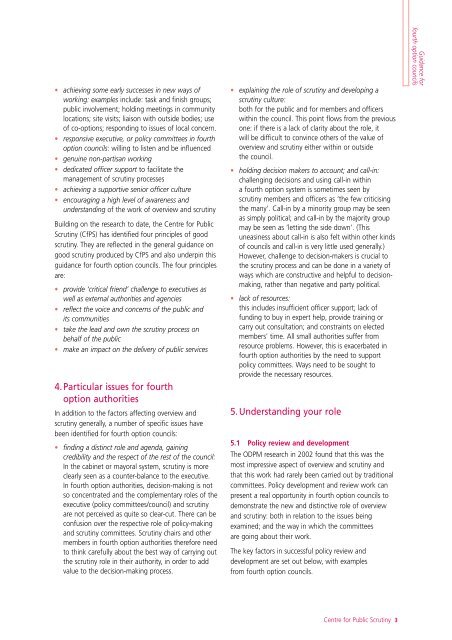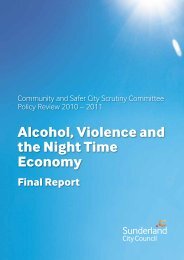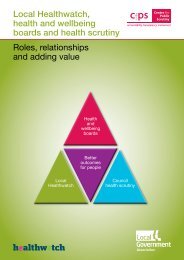Overview and Scrutiny Guidance for Fourth Option Councils
Overview and Scrutiny Guidance for Fourth Option Councils
Overview and Scrutiny Guidance for Fourth Option Councils
You also want an ePaper? Increase the reach of your titles
YUMPU automatically turns print PDFs into web optimized ePapers that Google loves.
• achieving some early successes in new ways ofworking: examples include: task <strong>and</strong> finish groups;public involvement; holding meetings in communitylocations; site visits; liaison with outside bodies; useof co-options; responding to issues of local concern.• responsive executive, or policy committees in fourthoption councils: willing to listen <strong>and</strong> be influenced• genuine non-partisan working• dedicated officer support to facilitate themanagement of scrutiny processes• achieving a supportive senior officer culture• encouraging a high level of awareness <strong>and</strong>underst<strong>and</strong>ing of the work of overview <strong>and</strong> scrutinyBuilding on the research to date, the Centre <strong>for</strong> Public<strong>Scrutiny</strong> (CfPS) has identified four principles of goodscrutiny. They are reflected in the general guidance ongood scrutiny produced by CfPS <strong>and</strong> also underpin thisguidance <strong>for</strong> fourth option councils. The four principlesare:• provide ‘critical friend’ challenge to executives aswell as external authorities <strong>and</strong> agencies• reflect the voice <strong>and</strong> concerns of the public <strong>and</strong>its communities• take the lead <strong>and</strong> own the scrutiny process onbehalf of the public• make an impact on the delivery of public services4. Particular issues <strong>for</strong> fourthoption authoritiesIn addition to the factors affecting overview <strong>and</strong>scrutiny generally, a number of specific issues havebeen identified <strong>for</strong> fourth option councils:• finding a distinct role <strong>and</strong> agenda, gainingcredibility <strong>and</strong> the respect of the rest of the council:In the cabinet or mayoral system, scrutiny is moreclearly seen as a counter-balance to the executive.In fourth option authorities, decision-making is notso concentrated <strong>and</strong> the complementary roles of theexecutive (policy committees/council) <strong>and</strong> scrutinyare not perceived as quite so clear-cut. There can beconfusion over the respective role of policy-making<strong>and</strong> scrutiny committees. <strong>Scrutiny</strong> chairs <strong>and</strong> othermembers in fourth option authorities there<strong>for</strong>e needto think carefully about the best way of carrying outthe scrutiny role in their authority, in order to addvalue to the decision-making process.• explaining the role of scrutiny <strong>and</strong> developing ascrutiny culture:both <strong>for</strong> the public <strong>and</strong> <strong>for</strong> members <strong>and</strong> officerswithin the council. This point flows from the previousone: if there is a lack of clarity about the role, itwill be difficult to convince others of the value ofoverview <strong>and</strong> scrutiny either within or outsidethe council.• holding decision makers to account; <strong>and</strong> call-in:challenging decisions <strong>and</strong> using call-in withina fourth option system is sometimes seen byscrutiny members <strong>and</strong> officers as ‘the few criticisingthe many’. Call-in by a minority group may be seenas simply political; <strong>and</strong> call-in by the majority groupmay be seen as ‘letting the side down’. (Thisuneasiness about call-in is also felt within other kindsof councils <strong>and</strong> call-in is very little used generally.)However, challenge to decision-makers is crucial tothe scrutiny process <strong>and</strong> can be done in a variety ofways which are constructive <strong>and</strong> helpful to decisionmaking,rather than negative <strong>and</strong> party political.• lack of resources:this includes insufficient officer support; lack offunding to buy in expert help, provide training orcarry out consultation; <strong>and</strong> constraints on electedmembers’ time. All small authorities suffer fromresource problems. However, this is exacerbated infourth option authorities by the need to supportpolicy committees. Ways need to be sought toprovide the necessary resources.5. Underst<strong>and</strong>ing your role5.1 Policy review <strong>and</strong> developmentThe ODPM research in 2002 found that this was themost impressive aspect of overview <strong>and</strong> scrutiny <strong>and</strong>that this work had rarely been carried out by traditionalcommittees. Policy development <strong>and</strong> review work canpresent a real opportunity in fourth option councils todemonstrate the new <strong>and</strong> distinctive role of overview<strong>and</strong> scrutiny: both in relation to the issues beingexamined; <strong>and</strong> the way in which the committeesare going about their work.The key factors in successful policy review <strong>and</strong>development are set out below, with examplesfrom fourth option councils.<strong>Guidance</strong> <strong>for</strong>fourth option councilsCentre <strong>for</strong> Public <strong>Scrutiny</strong> 3















![Absence Management [234kb] - Sunderland City Council](https://img.yumpu.com/28481957/1/184x260/absence-management-234kb-sunderland-city-council.jpg?quality=85)
